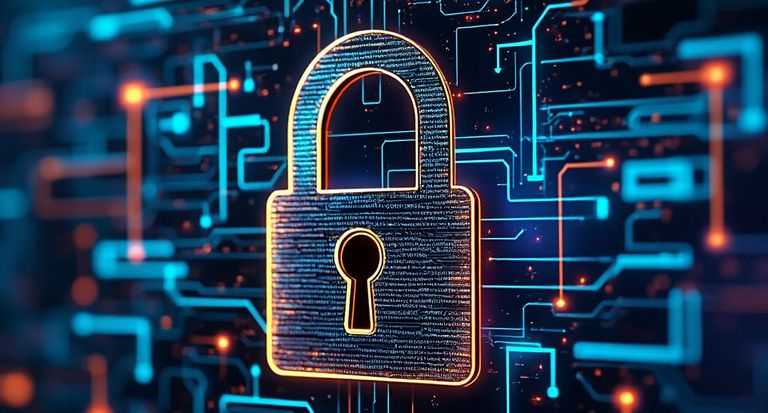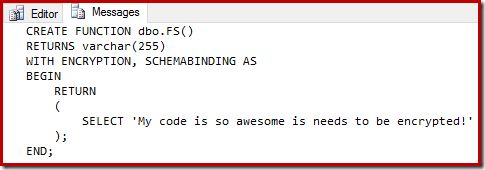The Internals of WITH ENCRYPTION

Reading Encryted Module Text
It is pretty easy for a SQL Server administrator to recover the text of stored procedures, views, functions, and triggers protected using WITH ENCRYPTION. Many articles have been written about this, and several commercial tools are available. The basic outline of the common method is to:
- Obtain the encrypted form (A) using the Dedicated Administrator Connection.
- Start a transaction.
- Replace the object definition with known text (B) of at least the same length as the original.
- Obtain the encrypted form for the known text ©.
- Roll back the transaction to leave the target object in its initial state.
- Obtain the unencrypted original by applying an exclusive-or to each character:
A XOR (B XOR C)
That is all pretty straightforward, but seems a bit like magic: It does not explain much about how and why it works. This article covers that aspect for those of you that find these sorts of details interesting, and provides an alternative method for decryption that is more illustrative of the process.
The Stream Cipher
The underlying encryption algorithm SQL Server uses for module encryption is the RC4™ stream cipher. An outline of the encryption process is:
- Initialize the RC4 cipher with a cryptographic key.
- Generate a pseudorandom stream of bytes.
- Combine the module plain text with the byte stream using exclusive-or.
We can see this process occurring using a debugger and public symbols. For example, the stack trace below shows SQL Server initializing the RC4 key while preparing to encrypt the module text:

This next one shows SQL Server encrypting the text using the RC4 pseudorandom byte stream:

Like most stream ciphers, the process of decryption is the same as encryption, making use of the fact that exclusive-or is reversible (A XOR B XOR B = A).
The use of a stream cipher is the reason exclusive-or is used in the method described at the start of the article. There is nothing inherently unsafe about using exclusive-or, provided that a secure encryption method is used, the initialization key is kept secret, and the key is not reused.
RC4 is not particularly strong, but that is not the main issue here. That said, it is worth noting that encryption using RC4 is being gradually removed from SQL Server and is deprecated (or disabled, depending on version and database compatibility level) for user operations like creating a symmetric key.
The RC4 Initialization Key
SQL Server uses three pieces of information to generate the key used to initialize the RC4 stream cipher:
-
The database family GUID.
This can be obtained most easily by querying
sys.database_recovery_status. It is also visible in undocumented commands likeDBCC DBINFOandDBCC DBTABLE. -
The target module’s object ID.
This is just the familiar object ID. Note that not all modules that allow encryption are schema-scoped. You will need to use metadata views (
sys.triggersorsys.server_triggers) to get the object ID for DDL and server-scoped triggers, rather thansys.objectsorOBJECT_ID, since these only work with schema-scoped objects. -
The target module’s sub-object ID.
This is the procedure number for numbered stored procedures. It is 1 for an unnumbered stored procedure, and zero in all other cases.
Using the debugger again, we can see the family GUID being retrieved during key initialization:

The database family GUID is typed uniqueidentifier, object ID is integer and sub-object ID is smallint.
Each part of the key must be converted to a specific binary format. For the database family GUID, converting the uniqueidentifier type to binary(16) produces the correct binary representation. The two IDs must be converted to binary in little-endian representation (least significant byte first).
Note: Be very careful not to accidentally provide the GUID as a string! It must be typed uniqueidentifier.
The code snippet below shows correct conversion operations for some sample values:
DECLARE
@family_guid binary(16) = CONVERT(binary(16), {guid 'B1FC892E-5824-4FD3-AC48-FBCD91D57763'}),
@objid binary(4) = CONVERT(binary(4), REVERSE(CONVERT(binary(4), 800266156))),
@subobjid binary(2) = CONVERT(binary(2), REVERSE(CONVERT(binary(2), 0)));Using ODBC escape syntax to provide a typed GUID constant
The final step to generate the RC4 initialization key is to concatenate the three binary values above into a single binary(22) and compute the SHA-1 hash of the result:
DECLARE
@RC4key binary(20) = HASHBYTES('SHA1', @family_guid + @objid + @subobjid);For the sample data given above, the final initialization key is:
0x6C914908E041A08DD8766A0CFEDC113585D69AF8The contribution of the target module’s object ID and sub-object ID to the SHA-1 hash are hard to see in a single debugger screenshot, but the interested reader can refer to the disassembly of a portion of initspkey below:
call sqllang!A_SHAInit
lea rdx,[rsp+40h]
lea rcx,[rsp+50h]
mov r8d,10h
call sqllang!A_SHAUpdate
lea rdx,[rsp+24h]
lea rcx,[rsp+50h]
mov r8d,4
call sqllang!A_SHAUpdate
lea rdx,[rsp+20h]
lea rcx,[rsp+50h]
mov r8d,2
call sqllang!A_SHAUpdate
lea rdx,[rsp+0D0h]
lea rcx,[rsp+50h]
call sqllang!A_SHAFinal
lea r8,[rsp+0D0h]
mov edx,14h
mov rcx,rbx
call sqllang!rc4_key (00007fff`89672090)The SHAInit and SHAUpdate calls add components to the SHA hash, which is eventually computed by a call to SHAFinal.
The SHAInit call contributes 10h bytes (16 decimal) stored at [rsp+40h], which is the family GUID. The first SHAUpdate call adds 4 bytes (as indicated in the r8d register), stored at [rsp+24h], which is the object ID. The second SHAUpdate call adds 2 bytes, stored at [rsp+20h], which is the subobjid.
The final instructions pass the computed SHA-1 hash to the RC4 key initialization routine rc4_key. The length of the hash is stored in register edx: 14h (20 decimal) bytes, which is the defined hash length for SHA and SHA-1 (160 bits).
The RC4 Implementation
The core RC4 algorithm is well-known, and relatively simple. It would be better implemented in a .NET language for efficiency and performance reasons, but there is a T-SQL implementation below.
These two T-SQL functions implement the RC4 key-scheduling algorithm and pseudorandom number generator, and were originally written by SQL Server MVP Peter Larsson. I have a made some minor modifications to improve performance a little and allow LOB-length binaries to be encoded and decoded. This part of the process could be replaced by any standard RC4 implementation.
/*
** RC4 functions
** Based on https://www.sqlteam.com/forums/topic.asp?TOPIC_ID=76258
** by Peter Larsson (SwePeso)
*/
IF OBJECT_ID(N'dbo.fnEncDecRc4', N'FN') IS NOT NULL
DROP FUNCTION dbo.fnEncDecRc4;
GO
IF OBJECT_ID(N'dbo.fnInitRc4', N'TF') IS NOT NULL
DROP FUNCTION dbo.fnInitRc4;
GO
CREATE FUNCTION dbo.fnInitRc4
(@Pwd varbinary(256))
RETURNS @Box table
(
i tinyint PRIMARY KEY,
v tinyint NOT NULL
)
WITH SCHEMABINDING
AS
BEGIN
DECLARE @Key table
(
i tinyint PRIMARY KEY,
v tinyint NOT NULL
);
DECLARE
@Index smallint = 0,
@PwdLen tinyint = DATALENGTH(@Pwd);
WHILE @Index <= 255
BEGIN
INSERT @Key
(i, v)
VALUES
(@Index, CONVERT(tinyint, SUBSTRING(@Pwd, @Index % @PwdLen + 1, 1)));
INSERT @Box (i, v)
VALUES (@Index, @Index);
SET @Index += 1;
END;
DECLARE
@t tinyint = NULL,
@b smallint = 0;
SET @Index = 0;
WHILE @Index <= 255
BEGIN
SELECT @b = (@b + b.v + k.v) % 256
FROM @Box AS b
JOIN @Key AS k
ON k.i = b.i
WHERE b.i = @Index;
SELECT @t = b.v
FROM @Box AS b
WHERE b.i = @Index;
UPDATE b1
SET b1.v = (SELECT b2.v FROM @Box AS b2 WHERE b2.i = @b)
FROM @Box AS b1
WHERE b1.i = @Index;
UPDATE @Box
SET v = @t
WHERE i = @b;
SET @Index += 1;
END;
RETURN;
END;
GO
CREATE FUNCTION dbo.fnEncDecRc4
(
@Pwd varbinary(256),
@Text varbinary(MAX)
)
RETURNS varbinary(MAX)
WITH
SCHEMABINDING,
RETURNS NULL ON NULL INPUT
AS
BEGIN
DECLARE @Box AS table
(
i tinyint PRIMARY KEY,
v tinyint NOT NULL
);
INSERT @Box
(i, v)
SELECT
FIR.i, FIR.v
FROM dbo.fnInitRc4(@Pwd) AS FIR;
DECLARE
@Index integer = 1,
@i smallint = 0,
@j smallint = 0,
@t tinyint = NULL,
@k smallint = NULL,
@CipherBy tinyint = NULL,
@Cipher varbinary(MAX) = 0x;
WHILE @Index <= DATALENGTH(@Text)
BEGIN
SET @i = (@i + 1) % 256;
SELECT
@j = (@j + b.v) % 256,
@t = b.v
FROM @Box AS b
WHERE b.i = @i;
UPDATE b
SET b.v = (SELECT w.v FROM @Box AS w WHERE w.i = @j)
FROM @Box AS b
WHERE b.i = @i;
UPDATE @Box
SET v = @t
WHERE i = @j;
SELECT @k = b.v
FROM @Box AS b
WHERE b.i = @i;
SELECT @k = (@k + b.v) % 256
FROM @Box AS b
WHERE b.i = @j;
SELECT @k = b.v
FROM @Box AS b
WHERE b.i = @k;
SELECT
@CipherBy = CONVERT(tinyint, SUBSTRING(@Text, @Index, 1)) ^ @k,
@Cipher = @Cipher + CONVERT(binary(1), @CipherBy);
SET @Index += 1;
END;
RETURN @Cipher;
END;
GOThe Encrypted Module Text
The easiest way for a SQL Server administrator to get this is to read the varbinary(max) value stored in the imageval column of sys.sysobjvalues, which is only accessible via the Dedicated Administrator Connection (DAC).
This is the same idea as the routine method described in the introduction though we add a filter on valclass = 1. This internal table is also a convenient place to get the subobjid. Otherwise, we would need to check sys.numbered_procedures when the target object is a procedure (using 1 for an unnumbered procedure and zero for anything else, as described previously).
It is possible to avoid using the DAC by reading the imageval from sys.sysobjvalues directly, using multiple DBCC PAGE calls. This involves a bit more work to locate the pages from metadata, follow the imageval LOB chain and read the target binary data from each page. The latter step is a lot easier to do in a programming language than T-SQL. Note that DBCC PAGE will work even though the base object is not normally readable from a non-DAC connection. If the page is not in memory, it will be read in from persistent storage as normal.
The extra effort to avoid the DAC requirement pays off by allowing multiple users to use the decrypting process concurrently. I will use the DAC approach in this article for simplicity and space reasons.
Worked Example
The following code creates a test encrypted scalar function:
CREATE FUNCTION dbo.FS()
RETURNS varchar(255)
WITH ENCRYPTION, SCHEMABINDING AS
BEGIN
RETURN
(
SELECT 'My code is so awesome is needs to be encrypted!'
);
END;The complete decryption implementation is below. The only parameter that needs changing to work for other objects is the initial value of @objectid set in the first DECLARE statement.
-- *** DAC connection required! ***
-- Make sure the target database is the context
USE Sandpit;
DECLARE
-- Note: OBJECT_ID only works for schema-scoped objects
@objectid integer = OBJECT_ID(N'dbo.FS', N'FN'),
@family_guid binary(16),
@objid binary(4),
@subobjid binary(2),
@imageval varbinary(MAX),
@RC4key binary(20);
-- Find the database family GUID
SELECT @family_guid = CONVERT(binary(16), DRS.family_guid)
FROM sys.database_recovery_status AS DRS
WHERE DRS.database_id = DB_ID();
-- Convert object ID to little-endian binary(4)
SET @objid = CONVERT(binary(4), REVERSE(CONVERT(binary(4), @objectid)));
SELECT
-- Read the encrypted value
@imageval = SOV.imageval,
-- Get the subobjid and convert to little-endian binary
@subobjid = CONVERT(binary(2), REVERSE(CONVERT(binary(2), SOV.subobjid)))
FROM sys.sysobjvalues AS SOV
WHERE
SOV.[objid] = @objectid
AND SOV.valclass = 1;
-- Compute the RC4 initialization key
SET @RC4key = HASHBYTES('SHA1', @family_guid + @objid + @subobjid);
-- Apply the standard RC4 algorithm and
-- convert the result back to nvarchar
PRINT CONVERT
(
nvarchar(MAX),
dbo.fnEncDecRc4
(
@RC4key,
@imageval
)
);Note the final conversion to nvarchar because module text is typed as nvarchar(max).
The output (including my typo) is:

Conclusion
The reasons the method described in the introduction works are:
- SQL Server uses the RC4 stream cipher to reversibly exclusive-or the source text.
- The RC4 key depends only on the database family guid, object id, and subobjid.
- Temporarily replacing the module text means the same (SHA-1 hashed) RC4 key is generated.
- With the same key, the same RC4 stream is generated, allowing exclusive-or decryption.
Users that do not have access to system tables, database files, or other admin-level access cannot retrieve encrypted module text. Since SQL Server itself needs to be able to decrypt the module, there is no way to prevent suitably privileged users from doing the same.
Thanks for reading.

This work is licensed under a Creative Commons Attribution-NonCommercial-ShareAlike 4.0 International License.
